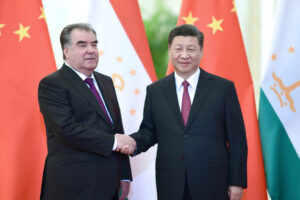Several coffee entrepreneurs say that high quality Arabica coffee is now increasingly difficult to obtain in Indonesia. Climate change makes it difficult to meet optimal conditions for growing coffee.
If you ask Rakhmad S. Saputra, owner of the Tador Coffee shop in Pasar Minggu, for recommendations for high-quality coffee, he will recommend arabica coffee from Kerinci, West Sumatra.
This coffee, served using the V60 method, has a less bitter taste and a fruity berry aroma, with a fragrance that remains on the tongue after swallowing. It’s one of the highest quality single origin coffees I’ve ever tried.
But if you had asked the same thing two or three years ago, Putra, as he is usually called, might have recommended a different coffee.
“Before Covid, around 2016-2018, coffee with unique flavors was cheap and easy to get. Well, if now the trend is for the original taste of coffee from a region that is consistent, we have to look for it, it takes more effort. “It’s not that easy anymore for us to get it,” said Putra.
As an experienced barista, Putra does not usually describe coffee based on regional origin – for example Sumatran coffee, Aceh coffee, and so on – but based on altitude. Until five years ago, he often looked for coffee supplies at an altitude of 1,300-1,500 meters above sea level (masl).
But he said farmers growing coffee at such altitudes were starting to experience problems they had never experienced before. Allegedly, the cause is climate change.
“Reports from farmers indicate that the harvest has failed or the amount of production has decreased because the plants tend to be damaged. “So the pests are stronger with changes in temperature at night which makes these plants diseased,” said Putra.
This situation forced Putra to look for coffee at higher altitudes, 1800-2000 meters above sea level. The 40-year-old man feels that coffee with good quality and good taste is now increasingly rare and the price is increasingly expensive, said Putra.
“Now the tendency is to buy extraordinarily expensive coffee with the quality we expect or buy too much and we can’t really guarantee that this coffee… will be what we expect,” he said.
Arabica coffee twilight?
Indonesia is the fourth largest coffee producer in the world after Brazil, Vietnam and Colombia, according to the International Coffee Organization (ICO). Meanwhile, in terms of consumption, Indonesia is in seventh place.
Coffee was first brought to Indonesia in the 17th century by Dutch colonialists. The Dutch colonial government established the first coffee plantations on the island of Java, and they were so successful that a cup of coffee was once known as “a cup of Java”. Later, coffee plantations spread to other islands such as Sumatra and Celebes (Sulawesi).
Nowadays, Indonesian coffee is popular with many coffee lovers in the world. Indonesian coffees – especially those from Sumatra, Java and Sulawesi – are renowned for their strong flavors and delicious earthy and fruity aromas.
There are two types of coffee that are widely grown in Indonesia, robusta and arabica. Robusta coffee has a relatively high caffeine content, 2.2-2.7%, and is famous for its bitter taste – or, as most people say, more kick.
Robusta coffee is more widely used in commercial coffee, consumed in the form of instant coffee or mixed drinks such as milk coffee which is popular among Indonesian consumers.
Most coffee produced in Indonesia, around 80%, is robusta coffee and the rest is arabica coffee, according to the Indonesian Coffee Export Association (GAEKI).
Meanwhile, arabica has a lower caffeine content than robusta, namely 1.2-1.5%. However, this type of coffee has a variety of flavors – more sour, smooth, or fruity.
Arabica coffee is often marketed as superior coffee from certain regions – for example Gayo Coffee, Bali Kintamani Coffee, Mandailing Coffee and Toraja Coffee. Some types of Arabica coffee have such a high taste that they have been named specialty.
Arabica coffee plants grow well in high places, above 1000 meters above sea level. Therefore, this type of coffee is more vulnerable to climate change.
Scientists even predict that, in the worst case scenario, wild arabica coffee could become extinct by 2080. Other studies show that at least 60% of the world’s coffee species (not just robusta and arabica) are threatened with extinction.
Scientists estimate that optimal conditions for growing Arabica coffee will become increasingly difficult to meet due to climate change, leading to reduced productivity and even crop failure. As a result, the volume of quality coffee that can be obtained by coffee entrepreneurs has also decreased.
This seems to have begun to be felt by several coffee entrepreneurs in Indonesia. One of them is Stefan Setiadi Tanuwijaya, owner of the Two Hands Full cafe and roastery, which specializes in Grade 1 and specialty coffees.
“So if we talk about top of the top, that’s right, playing at the top quality, specialty quality for single varieties, especially – so those that aren’t blended (mixed) – each variety itself goes down in volume,” said Stefan when I met in Bandung, last July.
According to Stefan, increasingly hot temperatures and the resulting spike in pests have caused the productivity and cupping quality of several coffee varieties to decline.
Temperatures that are too hot also dry out coffee beans more quickly, causing a change in the flavor profile.
“I really feel it, especially the natural process. “It’s a natural process, if the drying is too aggressive, it can produce a nutty quality [taste] which actually I don’t really like,” he said.
Stefan is not worried that his coffee business will be disrupted by the impact of climate change because new varieties will continue to be created.
However, he regrets that the coffee flavors we now enjoy may no longer exist in the future.
Impact of climate change
Wildan Mustofa, owner of the Java Frinsa Estate coffee plantation in Pangalengan, West Java, feels the impact of climate change.
Wildan remembers that when he was growing up in the highland town in the 1990s, he rarely saw animals such as lizards, mosquitoes or ants – because the climate was so cold. Now, he started to find them more often.
The middle-aged man explained that nowadays weather fluctuations have become more extreme in the dry season, very dry; when it rains, it’s very heavy. This condition has an impact on coffee plants.
“Previously, at 1,200 (masl) it was still safe, there were no attacks by coffee fruit borer pests (PBKo). Now in certain months, maybe once every 2-3 years I find PBKo (coffee berry borer) at an altitude of 1600 (masl).
“So it seems that because the air (temperature) is rising, finally the insects are getting higher and higher,” said Wildan when visited by BBC News Indonesia at the end of the harvest season, last July.
Farmers can respond to this change by growing coffee further up, added Wildan, but this will encroach on protected forest areas, which risks disrupting its environmental function as well as being an illegal action.
Due to extreme weather fluctuations and various derivative impacts, productivity per hectare in Wildan plantations tends to decline. He said in the last three years there has been a significant decline due to continuous rain throughout the year.
Apart from that, the coffee berries are also more spread out so it takes more time and money to harvest them.
“The harvest is already small, then the time takes longer so the harvest costs become more expensive. The cost of processing, drying like this becomes more expensive. “We need to use a greenhouse like this so we don’t get rained on,” Wildan explained.
Lower production and longer harvest times result in higher harvest costs, and ultimately the selling price of coffee beans becomes more expensive. According to Wildan, this makes Indonesian coffee less competitive in the global market.
“When world [coffee prices] fell, our [coffee prices] continued to rise so that now local prices are much higher than international prices,” said Wildan.
“So now the price of coffee, both Arabica and Robusta, is more expensive than before. And it’s not coming back like that.
“It went down because of the pandemic, but then it rose again, and has remained stable since 2010. I see the price trend continues to rise,” he added.
Apart from price, according to Wildan, coffee quality is also affected. Many studies have found that changes in light exposure, altitude, water pressure, temperature, carbon dioxide, and nutrient management can affect coffee quality.
The impact of these changes is an increase or decrease in secondary metabolites and sensory attributes that determine the taste of coffee.
“Now, the temperature is getting higher and higher, meaning that coffee at an altitude of 1,500 [masl] now is not as good as coffee at an altitude of 1,500 [masl] 10, 20 or 30 years ago. “It’s decreasing, the quality is decreasing,” said Wildan.
According to the International Coffee Organization (ICO), Indonesia is among the top four coffee producers in the world but its production is still far behind its competitors – Vietnam, Brazil, Colombia.
Cultivation techniques, most of which are still traditional, are said to be the factors causing low productivity of Indonesian coffee. That exacerbates, or at least doesn’t help, the problems caused by climate change, according to Wildan.
“Actually there are improvements, but the speed at which we improve is less than the speed of climate change. Others may be able to creep up their productivity. “We just crawled down like that,” he said.
Executive Secretary of the Indonesian Coffee Exporters Association (GAEKI) Ichwan Nursidik said the impact of climate change was already being felt in other coffee producing countries such as Brazil and Colombia.
However, even though production has fallen, world demand for coffee continues to rise consistently so coffee prices remain high. Coffee has now become part of the lifestyle not only in Indonesia, but also in several Asian countries.
With so many requests, according to Ichwan, a decrease in quality is not a problem.
“So if the price is high, usually the average quality will tend to go down because there is a lot of demand for coffee that is a little low [quality] and it sells well. Automatically, farmers will ‘why bother making good coffee’,” he said.
However, Ichwan believes that premium or Grade 1 coffee can maintain its quality.
“They [coffee farmers and entrepreneurs] will continue to process coffee because they already have a brand,” he said.
Slowly it will decrease
Fitrio Ashardiono, a climate change researcher from Ritsumeikan University in Japan, has been researching coffee in Indonesia since 2016. He started his research in Solok, West Sumatra, then in Ijen, East Java, and is now ongoing in Bondowoso, East Java.
According to Fitrio, extreme climate variations have an impact on reduced coffee production. In order to maintain production volumes, said Fitrio, farmers use methods such as “picking the rainbow” – not only picking coffee cherries that are red but also those that are still yellow and green, which are not yet very ripe.
“Even though production will remain the same, if the red, yellow and green [picks] are [counted] the quantity may slowly increase in yellow and green, so automatically the quality will slowly decrease,” he explained.
Fitrio also explained that unpredictable climate variations can have an impact on coffee bean processing. After being picked, the coffee is usually dried in the sun before being taken to the roastery to become coffee beans ready to be ground and brewed.
“Actually, of all the coffee processes, the most difficult is the natural process with the washed process. “It requires drying in natural sunlight,” Fitrio explained.
The natural process, also known as the dry process, is the process of drying whole coffee cherries in the sun. Meanwhile, in the washing process, the fleshy skin attached to the coffee beans is removed first before drying, by soaking it in water and using a depulper (peeler) machine.
“With climate change, the climate is automatically unpredictable; sometimes it suddenly rains… so the dryness is not as targeted – automatically the taste will change,” said Fitrio.
There are indications that this decline in taste is also felt in the country where Fitrio studied, in Japan, he added.
“Some of the roasters in Japan that I interviewed – they were talking about African [coffee] – for example, they bought one coffee that said it was 1,700 [masl], but when they tasted it it tasted like 1,500 [masl].
“This is anecdotal, yes. For them, they feel that the longer the coffee tastes, the worse it tastes. “Because it’s getting warmer, in my opinion,” he said.
Changes in agro-climatic conditions
Dodo Gunawan, a climate expert at the College of Meteorology, Climatology and Geophysics (an official school under BMKG) explained that global warming has caused changes in agro-climatic suitability. Areas that were suitable several years ago for growing certain agricultural commodities are no longer suitable.
And this applies to almost all commodities, he added, not just coffee. For example, Malang Apples were once famous; However, the increasingly warm air temperature in this city in East Java is no longer suitable for growing apples.
“In the case of animals, they will move to find a new suitability for them. But because the plant cannot move itself, it will respond with its products.
“In response to the unsuitability of the location because the climate has changed, production will decrease,” said Dodo.
He added that another indication of climate change is that extreme weather fluctuations are now occurring more frequently and their intensity is increasing.
Data from 91 BMKG observation stations shows an increasing trend in average air temperature since 1981, as well as a positive (hotter) anomaly since 2011. (The air temperature for the 1991-2020 period in Indonesia was 26.8 °C and the average air temperature in 2022 is 27.0 °C.)
Modeling by Schroth et al published in the scientific journal Regional Environmental Change in 2015 estimates that by 2050, once the impacts of climate change are truly felt, the area climatically and topographically suitable for growing Arabica coffee will be reduced by a third from the area suitable for current production. this (around 360,000 ha).
However, they also observed that not all areas suitable for growing coffee are currently actually being used for growing coffee. Therefore, the estimated area suitable for Arabica coffee in 2050 (240,000 ha) will still be 30% larger than the area used today.
Scientists are of the view that reduced production due to climate change can be compensated for by growing coffee in climatically suitable areas outside the current production zone.
How to adapt
To maintain the taste, coffee processors use methods such as the honey process and experiment with various fermentation techniques.
Fitrio views that these methods are tactics for adapting, when the feeling that “should be” is starting to be difficult to obtain.
Another way, suggested by Putra, is to develop robusta coffee that is more resistant to climate change.
Several coffee activists have started to test the potential of robusta coffee to be developed to specialty level, calling it fine robusta.
However, for some coffee lovers who have already fallen in love with the taste of Arabica coffee, the prospect of losing this coffee is not pleasant.
“Indeed, if we talk about coffee, I fell in love with coffee because of the flavor, the taste. “Indeed, so far the Arabica flavor cannot be replaced with Robusta, because the profile is very different,” said Stefan.
“So if we are strict, for example I am strict about looking for Arabica profiles, maybe one day there will be limitations. “It’s like… I can’t do that anymore,” he said.
Source: BBC















